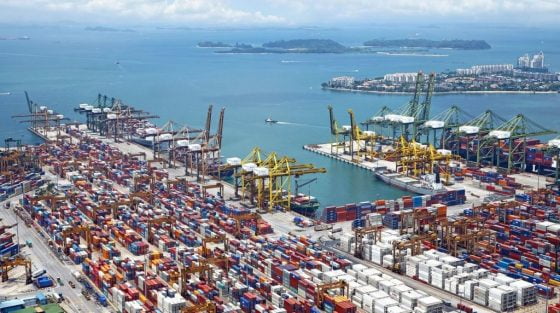This article was originally published by Belle Carter at Natual News.
The Port of Los Angeles has reported that its total throughput in October was 678,429 20-foot equivalent units (TEUs), almost 25 percent less compared to the same month last year. Meanwhile, imports totaled 336,307 TEUs – down 28 percent year-over-year.
The biggest drag was from incoming cargo that has shifted to the East and Gulf coasts due to protracted labor negotiations between West Coast port workers and their employers, Port of L.A. Executive Director Gene Seroka said during a news conference on Tuesday, Nov. 15.
This marks the lowest October import tally since the global financial crisis in 2009 and the lowest monthly imports since May 2020, during the peak of the Wuhan coronavirus (COVID-19) lockdowns. This year’s October imports were down 14 percent from October 2019.
According to Seroka, the steep decline is mainly due to three factors: a lack of a West Coast port labor contract, an early peak season and lower consumer spending on durables compared to purchases during the pandemic.
The port executive, as well as Los Angeles Mayor Eric Garcetti, repeatedly highlighted the labor issue during the news conference.
Seroka said he has been “knocking on doors,” speaking to shippers and carriers in the U.S., Asia, and Europe, and “looking to get that allocation back to Los Angeles.” But he admitted that “it starts with getting a labor agreement.”
Garcetti, meanwhile, insisted that there will not be a strike. “I don’t say this as someone trying to market [Los Angeles], but the remaining issues are so much more minor than in past years when we’ve been able to resolve this,” the mayor said.
Recent reports said the Port of New York/New Jersey has unseated L.A. as America’s busiest port. But Seroka isn’t worried. (Related: Freight companies expect “muted peak season” due to waning retailer demand.)
“We have been in the No. 1 position for 22 consecutive years and one or two months [in second place] is not going to create a trend. Our dwell times have improved and the shipping backlog is nearly gone. We’re eager to ramp volume back up,” he said.
October imports at Port of Long Beach also decline
The Port of Long Beach also reported a 24 percent year-on-year drop in October imports to 293,924 TEUs, which makes for the port’s lowest import number in any month since April 2020 and its lowest import total for the month of October since 2012. The decline was 13 percent from October 2019.
Port officials blamed the reduced consumer demand, which has caused retailers to cut back on their imports. “After having brought in large quantities of merchandise earlier in the year, retail inventories are high contributing to the slowdown,” one official said.
Port of Long Beach executives also acknowledged that there has been a shift of imported goods toward the Gulf and East coast ports, which many industry analysts attribute to the prior backlogs in Southern California as well as the fears of potential labor actions as the contract negotiations for Pacific Coast dockworkers have dragged on since their contract expired on July 1.
But Port of Long Beach Executive Director Mario Cordero believes that the supply chain will be back to normal and cargo will continue to move.
“I am optimistic that store shelves will be stocked and goods will be available for delivery during the holiday season. Over the long term, the San Pedro Bay ports complex will continue to be a competitive, strategic and sustainable gateway for trans-Pacific trade,” Cordero stated.
Collapse.news has more on the collapsing transportation and freight industries in the United States.
This video talks about ocean freight rates in the ports of Los Angeles and Long Beach.










0 Comments